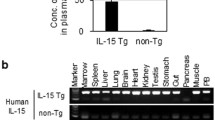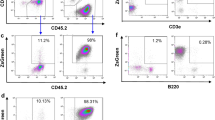Summary
The influence of in vivo infection with the polycythemic substrain of Friend leukemia virus on noninducible (‘natural’) resistance against allogeneic normal or malignant grafts was studied in lethally irradiated mice. Parallel studies were performed on the NK system in the same experimental conditions. The results indicate that FLV-P infection of mice with full (DBA/2) vs partial (BALB/c and CD2F1) susceptibility did not suppress their in vivo natural resistance against bone marrow or El-4 leukemia cells. On the other hand, a decline in NK activity paralleled the progression of leukemic disease in the more susceptible DBA/2 hosts.
Similar content being viewed by others
References
Bennett M (1972) Rejection of marrow allograft. Transplantation 14:288
Bonmassar E, Cudkowicz G (1976) Suppression of allogeneic lymphomas in spleens of irradiated mice: importance of the D end of the H-2 complex. J Immunol 117:697
Bonmassar E, Campanile F, Houchens D, Crinò L, Goldin A (1975) Impaired growth of a radiation-induced lymphoma in intact or lethally irradiated allogeneic athymic (nude) mice. Transplantation 20:343
Bonmassar E, Riccardi C, Campanile F, Iorio A, Puccetti P, Herberman RB (1979) Radioresistant inhibition of tumors (RIT): biological and pharmacological studies. In: Ferrone S, Herberman RB, Gorini S, Reisfeld RA (eds) Current trends in tumor immunology. Garland, New York London, p 49
Bonmassar A, Riccardi C, Rivosecchi-Merletti P, Goldin A, Bonmassar E (1980) Transplantation resistance of drug-treated hybrid or allogeneic mice against murine lymphomas. I. Immunopharmacology studies. Int J Cancer 26:819
Campanile F, Crinò L, Bonmassar E, Houchens D, Goldin A (1977) Radioresistant inhibition of lymphoma growth in congenitally athymic (nude) mice. Cancer Res 37:394
Cikes M, Friberg S Jr, Klein G (1973) Progressive loss of H-2 antigens with concomitant increase of cell-surface antigen(s) determined by Moloney leukemia virus in cultured lymphomas. J Natl Cancer Inst 50:347
Clark EA, Harmon RC (1980) Genetic control of natural cytotoxicity and hybrid resistance. Adv Cancer Res 31:227
Cudkowicz G (1968) Hybrid resistance to parental grafts of hematopoietic and lymphoma cells. In: The proliferation and spread of neoplastic cells Williams and Wilkins, Baltimore, p 661
Cudkowicz G (1969) Hybrid resistance and parental specific transplantation antigens. In: Rose MR, Milgrom F (eds) Proceedings International Convocation on Immunology. Karger, Basel, p 193
Cudkowicz G (1975) Genetic control of resistance to allogeneic and xenogeneic bone marrow grafts in mice. Transplant Proc 7:155
Cudkowicz G, Hocham PS (1979) Do natural killer cells engage in regulated reactions against self to ensure homoestasis? Immunol Rev 44:13
Cudkowicz G, Rossi GB, Haddad JR, Friend C (1972) Hybrid resistance to parental DBA/2 grafts: independence from the H-2 locus. II. Studies in Friend virus-induced leukemia cells. J Natl Cancer Inst 48:997
Friend C (1957) Cell-free transmission in adult Swiss mice of a disease having the character of a leukemia. J Exp Med 105:307
Garaci E, Migliorati G, Jezzi T, Bartocci A, Gioia L, Rinaldi C, Bonmassar E (1981) Impairment of in vitro generation of cytotoxic or T suppressor lymphocytes by Friend leukemia virus infection in mice. Int J Cancer 28:367
Gorelik E, Wiltrout R, Okumura K, Habu S, Herberman RB (1982) Acceleration of metastatic growth in anti-Asialo GM1-treated mice. In: Herberman RB (ed) NK cells and other natural effector cells. Academic Press, New York, p 1331
Habu S, Fukui H, Shimamura K, Kasai M, Nagai Y, Okumura K, Tamaoki N (1981) In vivo effects of anti-Asialo GM1. I. Reduction of NK activity and enhancement of transplanted tumor growth in nude mice. J Immunol 127:24
Haller O, Orn A, Gidlund M, Wigzell H (1980) In vitro activity of murine NK cells In: Herberman RB (ed) Natural cell-mediated immunity against tumors. Academic Press, New York, p 1105
Hanna N (1982) Inhibition of experimental tumor metastasis by selective activation of natural killer cells. Cancer Res 42:1337
Harmon RC, Clark EA, Toole CO, Wicker LS (1977) Resistance of H-2 heterozygous mice to parental tumors. I. Hybrid resistance and natural cytotoxicity to EL-4 are controlled by the H-2D-Hh-1 region. Immunogenetics 4:601
Harrison DE, Carlson GA (1983) Effects of the beige mutation and irradiation on natural resistance to marrow grafts. J Immunol 130:484
Herberman RB (1982) Natural killer cells and their possible relevance to transplantation biology. Transplantation 34:1
Hochman PS, Cudkowicz G (1979) Suppression of natural cytotoxicity by spleen cells of hydrocortisone-treated mice. J Immunol 123:968
Hofer KG, Hughes L (1970) Incorporation of iododeoxy-uridine 125I into the DNA of L1210 leukemia cells during tumor development. Cancer Res 30:236
Houchens D, Iorio A, Barzi A, Goldin A, Bonmassar E (1975) Inhibition of anti-lymphoma allograft response in normal and lethally irradiated mice by cyclophosphamide (NCS 26271) and isophosphamide (NCS 109724). Cancer Chemother Rep 59:967
Iorio A, Campanile F, Neri M, Spreafico F, Goldin A, Bonmassar E (1978) Inhibition of lymphoma growth in the spleen and liver of lethally irradiated mice. J Immunol 120:1679
Iorio A, Neri M, Enrico P, Bonmassar E (1981) Inhibition of hybrid resistance to lymphomas by inactivated tumor cells in lethally irradiated mice. Transplantation 32:355
Kasai M, Leclerc JC, McVay-Boudreau L, Shen FW, Cantor H (1979) Direct evidence that natural killer cells in non-immune spleen cell population prevent tumor growth in vivo. J Exp Med 149:1260
Kiessling R, Hochman PS, Haller O, Shearer GM, Wigzell H, Cudkowicz G (1977) Evidence for a similar or common mechanism for natural killer cell activity and resistance to hemopoietic grafts. Eur J Immunol 7:655
Kumar V, Luevano E, Bennett M (1978) Hybrid resistance to EL-4 lymphoma cells. I. Characterization of natural killer cells that lyse EL-4 cells and their distinction from marrow dependent natural killer cells. J Exp med 150:531
Lotzovà E (1980) Analogy between rejection of hemopoietic transplants and natural killing. In: Herberman RB (ed) Natural cell-mediated immunity against tumors. Academic Press, New York, p 1117
Lotzovà E, Pollack SB, Savary CA (1982) Direct evidence for the involvement of natural killer cells in bone marrow transplantation. In: Herberman RB (ed) NK cells and other natural effector cells. Academic Press, New York, p 1535
Migliorti G, Jezzi T, Favalli G, Garaci E, Rossi GB, Bonmassar E (1982) Impairment of splenic natural killer cell activity in mice infected with the polycythemic strain of Friend leukemia virus. Cancer Immunol Immunother 12:177
Migliorati G, Jezzi T, Frati L, Bonmassar E, Rossi GB, Garaci E, Riccardi C (1983) Modulation of natural killer (NK) cell activity during FLV-P virus infection of mice. Int J Cancer 31:81
Mirand EA, Steevens RA, Lange RD, Grace JT (1968) Virus-induced polycythemia in mice: erythropoiesis without erythropoietin. Proc Soc Exp Biol Med 128:844
Mortensen RF, Ceglowski WS, Friedman H (1973) Leukemia virus-induced immunosuppression. IX. Depression of delayed hypersensitivity and MIF production after infection of mice with Friend leukemia virus. J Immunol 111:1810
Okumura K, Habu S, Shimamura K (1982) The role of Asialo GM1+ (GA1+) cells in the resistance to transplants of bone marrow or other tissues. In: Herberman RB (ed) NK cells and other natural effector cells. Academic Press, New York, p 1527
Plata F, Goodenow MM, Lilly F (1980) Studies of cloned Friend erythroleukemia tumor cells. Modulation of the tumor-specific cytolytic T lymphocyte response by infectious Friend virus production in vitro. J Exp Med 151:726
Pollack SB, Hallenbeck LA (1982) In vivo reduction of NK activity with anti-NK1 serum: direct evaluation of NK cells in tumor clearance. Int J Cancer 29:203
Riccardi C, Santoni A, Barlozzari T (1979) Immunomodulation of natural reactivities against tumors. Chemioter Oncologica 4:299
Riccardi C, Santoni A, Barlozzari T, Herberman RB (1980) Role of NK cells in rapid in vivo clearance of radiolabeled tumor cells. In: Herberma RB (ed) Natural cell-mediated immunity against tumors. Academic Press, New York, p 1121
Riccardi C, Santoni A, Barlozzari T, Puccetti P, Herberman RB (1980) In vivo natural reactivity of mice against tumor cells. Int J Cancer 25:475
Roder JC, Haliotis T (1980) Do NK cells play a role in antitumor surveillance? Immunology Today 1:96
Rossi GB, Cudkowicz G, Friend C (1970) Evidence for transformation of spleen cells one day after infection of mice with Friend leukemia virus. Autonomous growth potential and expression of hybrid-resistance genes. J Exp Med 131:765
Rowson KE, Mahy BWJ (1975) Lactic dehidrogenase virus. Virol Monogr 13:1
Talmadge JE, Meyers KM, Prieur DJ, Starkey JR (1980) Role of NK cells in tumor growth and metastasis in beige mice. Nature 284:622
Thorn RM, Henney CS (1976) Kinetic analysis of target cell destruction by effector T cells. I. Delineation of parameters related to the frequency and lytic efficiency of killer cells. J Immunol 117:2213
Warner JF, Dennert (1982) Effects of a cloned cell line with NK activity on bone marrow transplants, tumor development and metastasis in vivo. Nature 300:31
Warner NL, Woodruff MF, Burton RC (1977) Inhibition of the growth of lymphoid tumours in syngeneic athimic (nude) mice. Int J Cancer 20:146
Author information
Authors and Affiliations
Additional information
Abbreviations used: FLV-P, N-tropic polycythemic substrain of Friend Leukemia Virus Complex; NR, natural resistance; NR in vivo, natural resistance against normal or malignant hemopoietic grafts occurring in vivo in lethally irradiated mice; NK, natural killer; (125I)IUdR, 125I-labeled 5-iodio-2′-deoxyuridine; IV, intravenous
Rights and permissions
About this article
Cite this article
Iorio, A.M., Neri, M., Enrico, P. et al. Natural resistance against hematopoietic cells in lethally-irradiated mice infected with Friend leukemia virus. Cancer Immunol Immunother 18, 35–40 (1984). https://doi.org/10.1007/BF00205397
Received:
Accepted:
Issue Date:
DOI: https://doi.org/10.1007/BF00205397




